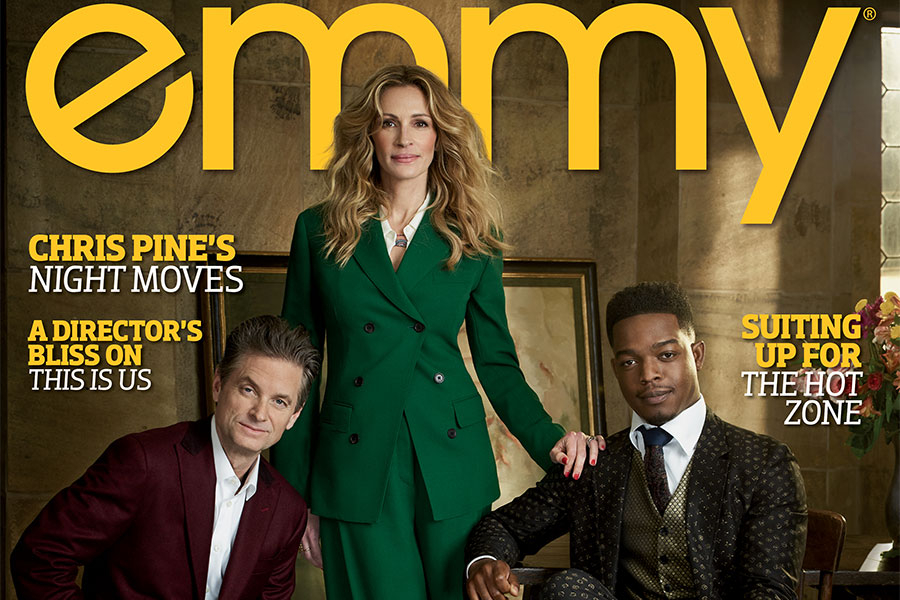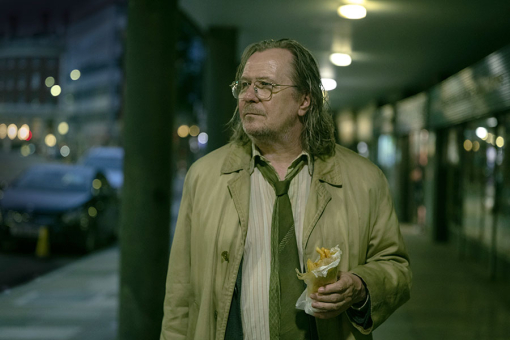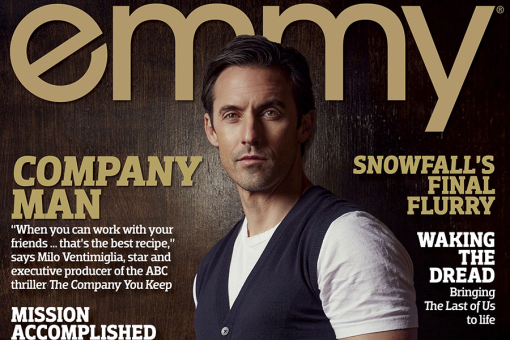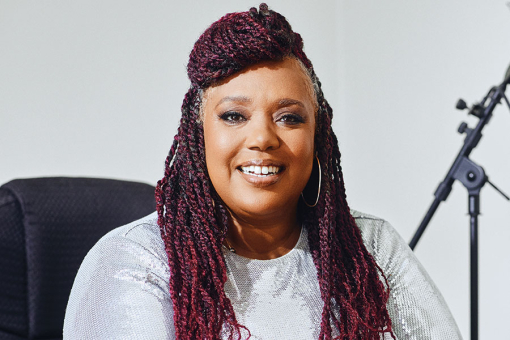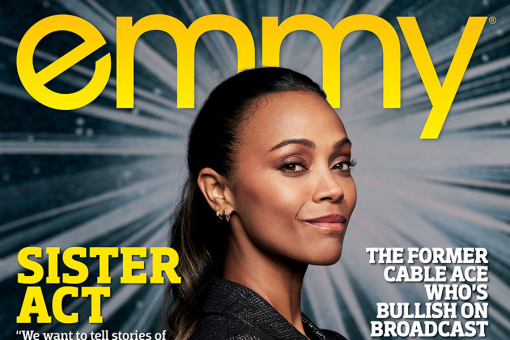Before she signed on to star in Amazon Prime Video’s Homecoming, Julia Roberts had concerns about returning to television after so many years.
First, there were the long hours. “I have a lot of friends that work on TV as crewmembers, and I’ve heard for years and years about the grind of television,” she says. “I just thought, ‘These hours sound like they can be insufferable — on Fridays you work until Saturday, then you’re back at the crack of dawn by Monday.’”
What she was not prepared for — having made her debut in 1987 on NBC’s Crime Story and amassing nearly 60 credits since then — was how to read the call sheet.
“I was getting all these pre-production emails and thought, ‘Gosh, what are people talking about? Block one, block two — letters that I didn’t understand,’” she says.
Good thing she’d worked on The Pelican Brief in the early ’90s with Peter Kohn, the first assistant director on Homecoming. “I went into the production office and said to him, ‘I need a fast lesson in the nomenclature of television, because I am not understanding the call sheet’ — which, 30 years later, I should pretty much have down.”
She had no doubts about the project itself. Back in 2016, after receiving an advance link to the Gimlet Media podcast of the same name, Roberts found herself in its thrall.
“It was the first podcast that I listened to that was one story, fiction, and was like an old-fashioned radio show,” she says. “I was so hooked on that idea. And the story was great. I thought it was produced so well. The sound design? I thought that was incredible. The bubbles of the fish tank? I was completely smitten.”
Created by Eli Horowitz and Micah Bloomberg, Homecoming plays out in timelines four years apart, so it offered Roberts the chance to appear in what is essentially a dual role. The 2018 Heidi Bergman is a newly hired caseworker at the Homecoming Transitional Support Center, a Florida facility that rehabilitates soldiers with PTSD.
There, as she fields regular calls from her fast-talking, opportunistic supervisor Colin Belfast (Bobby Cannavale), she finds a favorite patient in Walter Cruz (Stephan James).
In the future scenes, Roberts’s defeated-looking Heidi lives with her mother (Sissy Spacek) and works as a waitress at a ramshackle seafood restaurant. When confronted by Department of Defense investigator Thomas Carrasco (Shea Whigham), she realizes she has only faint memories of her previous job.
“They each have a very specific sense of focus, so as an actor I’d just concentrate on the different versions of Heidi,” Roberts says. “The Heidi in the facility has this incredible, almost Girl Scout sense of excitement and pride in what she’s doing, and she really believes she’s helping people and making them more capable of accomplishing their goals. She’s so earnest in her initial pursuits there.”
And future Heidi? “She’s sort of run out of steam. She’s back in her hometown, and her relationship with her mother is very complicated and sad. She’s just broken, very ‘How did this happen?’”
Only once did Roberts have to toggle between the two Heidis on the same day. “I don’t remember what we filmed, but I was one Heidi before lunch and another Heidi after,” she says. “I was glad there was that one day so I could appreciate all the other days we didn’t do that. It was humorlessly tricky.”
Homecoming took the leap to television when UCP optioned the rights to the podcast in connection with director Sam Esmail (Mr. Robot), who has an overall deal at the studio.
Roberts was next to come aboard, and when she set the terms of her participation, the contours of the project changed: creator-showrunners Horowitz and Bloomberg were to write all 10 scripts before production began, and Esmail, who had hoped to direct the first two half-hour episodes, was to stay on as sole director.
(USA Network allowed for an extended hiatus on Esmail’s Mr. Robot to accommodate the filming schedule; Esmail also executive-produces Homecoming, along with Bloomberg, Horowitz, Roberts, Chad Hamilton, Alex Blumberg, Matt Lieber and Chris Giliberti.)
“Our ideas for [the show] were so specific and stylish, and the tone is so surgical,” Roberts says. “I felt that to have a synchronicity, [the director] had to be one person. Maybe eight or 10 people can harmonize like that. But I felt that it needed one person to be the captain.”
Amazon Studios head Jennifer Salke, who has always been forthright about her campaign to attract big names, notes that the one-captain arrangement can ease a film star’s transition to episodic work.
“When stars of Julia’s caliber sign on to these kinds of shows, they really want to know who’s executing, who they’re going to be side by side with every day,” says Salke, who inherited Homecoming when she took over the studio in February 2018.
“Look at shows like this and [HBO’s] Big Little Lies — so much about wanting to be engaged in ongoing series is based on how those experiences feel. The fact that there was a consistency of direction through the first season gave [Julia] great comfort.”
Esmail brought consistency — and also a casting brainstorm. “My fanboy side took over,” says the director, who calls himself a great admirer of the 1997 romantic comedy My Best Friend’s Wedding. In the film, Roberts’s Julianne Potter tries to sabotage the impending nuptials of the man she yearns for, her old friend Michael, played by Dermot Mulroney.
What if Mulroney played Anthony, Heidi’s live-in boyfriend during her tenure at the rehab center, toward whom she is almost comically dismissive? When Esmail ran what was essentially a Wedding reunion sight gag past Roberts, he wanted to know two things: 1 ) What did she think? and 2 ) Did she know how to get in touch with her square-jawed costar of yore?
“Not only did she love the idea, but she was really good friends with Dermot, which sort of blew my mind,” Esmail recalls. “It was like, ‘Wait a minute. You guys are actually really close?’ And when he came to the table read and they started talking, he called her ‘Jules.’ Again: Mind blown.”
That real-life friendship proved helpful. “We didn’t have a lot of time to rehearse, so Dermot and I would talk on the phone about a lot of things, have our ducks in a row a little bit more cleverly than if it was someone that I didn’t have a friendship with already,” Roberts says. “It was such inspired casting.
"We’d just laugh performing these scenes together. I’d say, ‘This is the revenge of Julianne. Now the shoe is on the other foot.’”
Putting in a quick, cajoling call to her old friend Dermot was one thing. The Heidi-and-Walter chemistry reads, however, unexpectedly triggered a torrent of emotions.
“I don’t know if it was my actor instincts or my maternal instincts, but it all came screaming back to me, those feelings of wanting to get a job, trying to do all the right things and in under six-and-a-half minutes prove yourself in a room of people you don’t know,” says Roberts, who tried to chat up her scene partners before the auditions began in earnest.
Stephan James, who was making If Beale Street Could Talk at the time, says he was so overwhelmed by having to memorize 12 pages of dialogue that he didn’t get nervous about working with one of Hollywood’s most iconic movie stars — until he walked into the room and greeted her by extending his hand.
“That’s when it really hit me,” he says. He recalls she peppered him with questions about his hometown of Toronto, about food, about work.
“She helped break the ice in a way that was so cool of her. Meanwhile all the producers and our director were waiting for us to start, and she just allowed us to have time, a moment, in front of everyone.”
James’s natural buoyancy and aura of innocence brought a new take on Walter Cruz. As voiced by Oscar Isaac on the podcast, the soldier had a more circumspect, less playful quality.
Meanwhile, Roberts, who admits she tried “for absolute days” to mimic the husky vocal inflections of Catherine Keener’s podcast Heidi (“It turns out that she’s not imitatable”), brought an arsenal of mannerisms and gestures instantly familiar to generations of moviegoers.
“The role is pretty subdued — not your classic Julia Roberts role — but to have this switch that could be flipped whenever needed?” Horowitz says.
“It could be the smile that feels like the clouds are parting and the sun is shining. The fact that that was always there, waiting, really helped build this character, really kept the story moving. It was like this nuclear weapon that could be deployed whenever it was necessary.”
“What’s crazy about Julia,” Bloomberg adds, “is that she’s always prepared, always ready. But between takes she is the most personable, funny, the goofiest. She’s very chill, hanging out, cracking jokes. And then you turn on the camera and she’s breaking down, crying, having this experience — and it’s as powerful, intense and deep as you could ever hope for.
"Then you turn off the camera, and it’s back to joking around. It seems effortless. I’m sure it’s not, but that’s my impression.”
All the light and dark that is Homecoming took shape in a space that its creators could hardly have conceived when they recorded their micro-budget podcast in one week in a Flatbush Avenue office building.
The world of the streaming series is one that Horowitz and Bloomberg could physically enter: 36,000 square feet of residents’ bedrooms, an atrium, a cafeteria and Heidi’s office, all spread out over two connected soundstages on the Universal lot. “Seeing the incarnation of this almost imaginary nonsense, that’s when it became surreal and thrilling,” Horowitz says of production designer Anastasia White’s meticulously detailed set.
It was easier to build this world, Esmail explains, than to spend weeks looking for an existing structure that fit his and White’s exacting specifications.
“We wanted it to look like an office park somehow turned into a forced-homey welcoming center for soldiers,” he says, adding that fabricating the two-story set allowed him to do things like install a removable ceiling so the crew could fit in a crane as well as overhead lights.
“Knowing that 70 percent of the series was in this location, it was really important to me that I have as many options as possible on how we filmed it, to keep it as visually interesting as possible,” he says. For example, filming the vets from above conveyed the sense that they were being surreptitiously examined “like under a microscope, being poked and prodded without their knowledge.”
Watching a couple episodes of Homecoming, any Esmail fan will recognize his distinctive visual style: long, long tracking shots and bird’s-eye-view angles.
To make it easy for viewers to identify the timeframe, Esmail and cinematographer Tod Campbell (Mr. Robot, Stranger Things) used different aspect ratios; for 2018, they shot in widescreen, and when the story leaps into the future, the action is filmed in a 1:1 box.
Roberts calls the fluctuating aspect ratio device “one of my favorite things.” Even so, she admits that when Esmail tried to bring her into the loop on the first day of tests, she walked away puzzled. “Sam was like, ‘Julia! Come and look at the monitor!’ So I come and look at the monitor and there’s [nothing] but a black square, and I’m waiting for an image to come up.
"And I said, ‘What am I looking at?’ and he said, ‘It’s a perfect black square! It’s incredible!’ It’s shameful, being a cinematographer’s wife” — Roberts is married to director of photography Danny Moder — “but he was so excited, and I was in the dark.”
When this year’s Golden Globes rolled around, Homecoming, Roberts and Stephan James all received nominations. Despite the accolades, it’s been reported that Roberts’s Heidi character won’t be returning for season two. Because she remains an executive producer, though, Roberts still suffers the occasional pang when reading Horowitz and Bloomberg’s new scripts. She hasn’t locked that door entirely.
“I keep finding out things every week where I go, ‘Well, wait a minute! What about me? If they ’re going to do that, shouldn’t I be there to do this?’ ” she says.
“I don’t want to miss the party, but at the same time, for me, so much of Homecoming was having Sam Esmail as the leader of the ship. [He is reportedly not returning to direct but will also remain an executive producer.] So much of it depends on when they want to shoot it. ”
This much is certain: Roberts isn’t about to weigh in on the mysterious first-season ending, which involves a diner, Heidi and Walter, and the angle of a piece of cutlery that may or may not indicate something.
“One day, Sam and I were doing press together and I was just blown away by how many ideas and theories people had about the fork. I was like, ‘Wait. What?’ That’s when I realized that there is no [benefit] in saying, ‘This is what we thought it meant.’ That’s what makes this show so fun: every time you think you’ve got your story straight, then it changes.”
Go behind the scenes of emmy’s Homecoming cover shoot at TelevisionAcademy.com/cover.
This article originally appeared in emmy magazine, Issue No. 5, 2019

